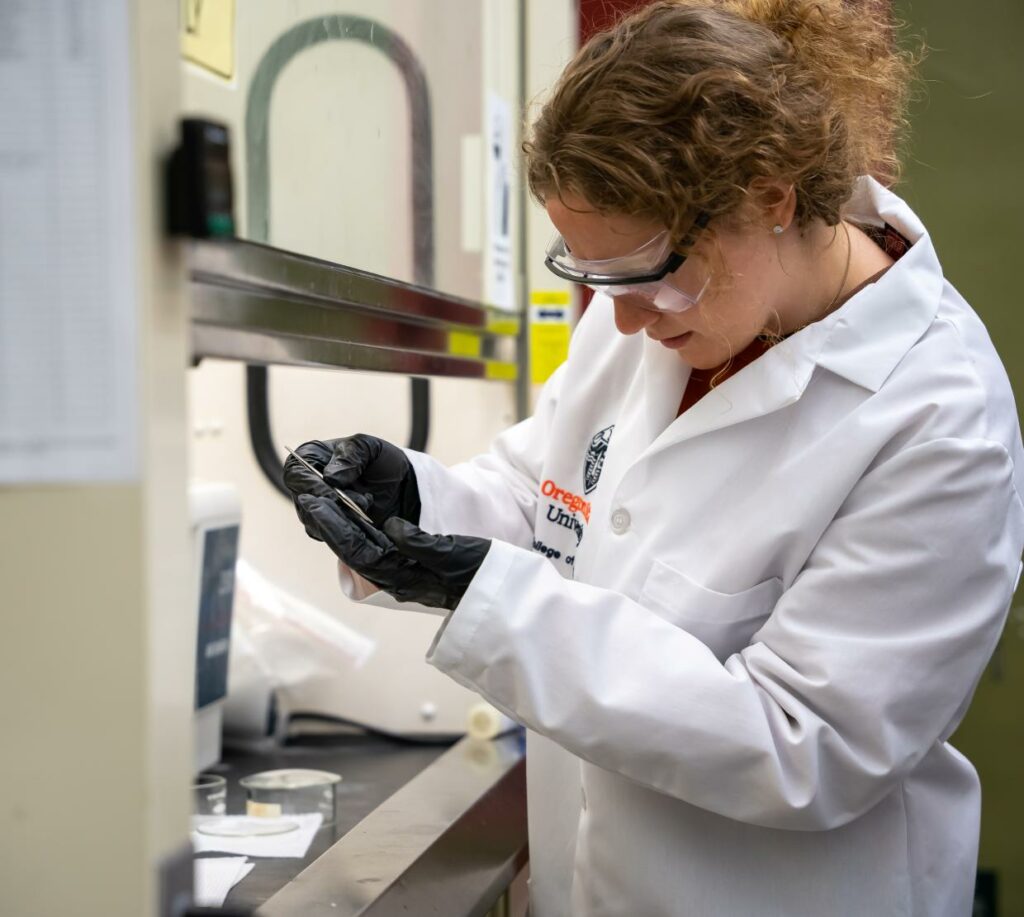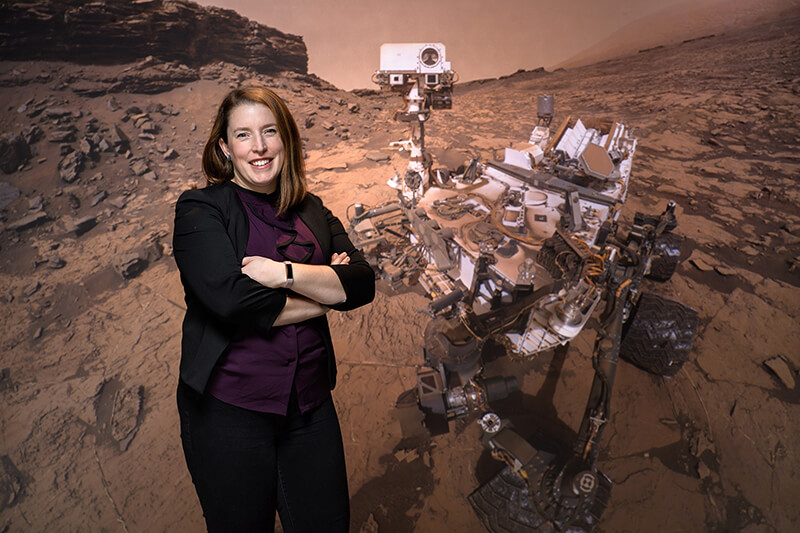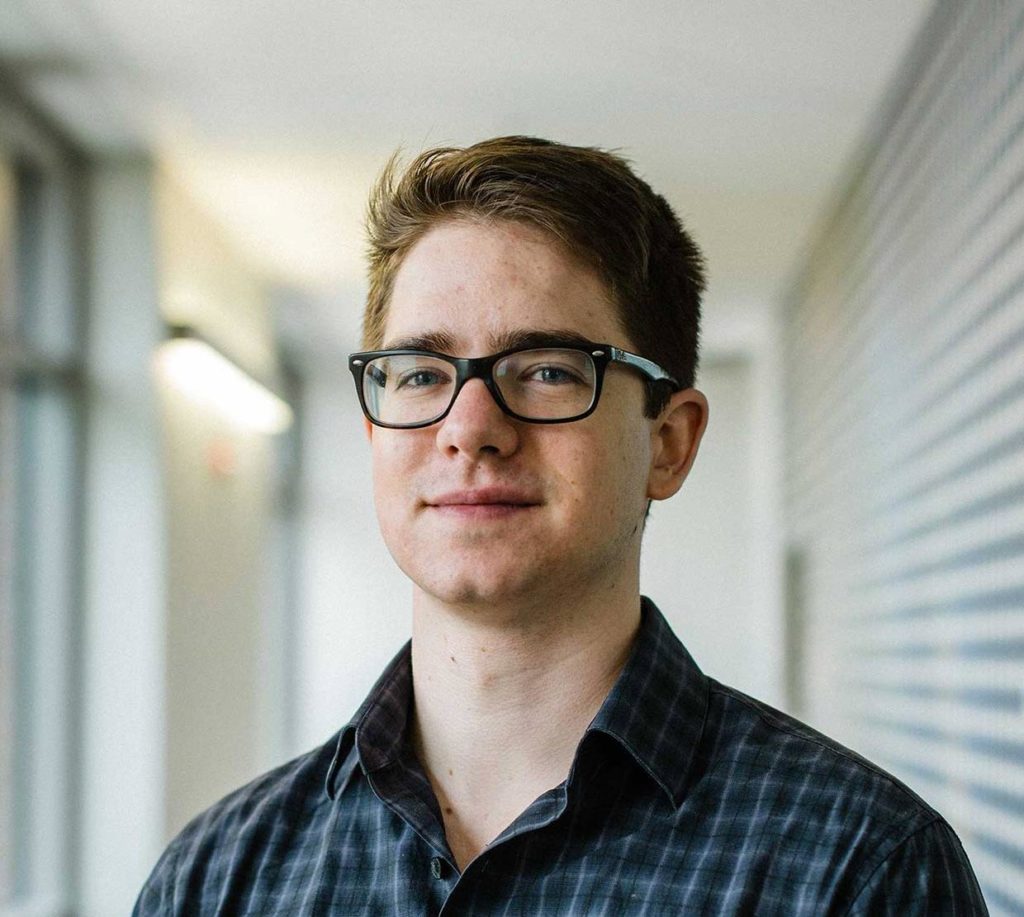The College of Science Impact blog has a post by Elana Roldan about recent graduate and Goldwater Scholar Madalyn Gragg


The College of Science Impact blog has a post by Elana Roldan about recent graduate and Goldwater Scholar Madalyn Gragg

For International Women’s Day, I’m reposting a history of one of our most distinguished alumni, Dr. Chung Kwai Lui. Dr. Lui was the first woman to receive a doctorate in any field from OSU and was nationally recognized for her work on the Manhattan project and at Westinghouse on phosphor development. The Wei Family Private Foundation has established a scholarship in honor of her and her husband Hsin Hsu Wei.
This was originally posted on our website as OSU’s First Woman Physics PhD by Ken Krane.
There is more information about Dr. Lui and legacy provided by the Wei Family Private Foundation in this article from the College of Science.

Chung Kwai Lui was born in Canton, China in 1909. In 1929, she enrolled at Lingnan University, which had been established as a Christian college in 1888 by American missionaries in Guangzhou. The reputation of the college grew quickly, and by 1918 the leading U.S. universities, including Harvard, Yale, and Stanford, were accepting its students for graduate programs. Miss Lui chose physics as her major and completed her undergraduate degree in 1933. In addition to the regular curriculum of physics courses, she also took courses in science teaching, and from 1933 until 1936 she taught physics at the middle-school level. At the same time she enrolled in graduate courses in physics at Lingnan University.
In 1936, the Oregon State chapter of Phi Kappa Phi (an academic honor society) offered Miss Lui an exchange scholarship, which covered her tuition and room. She moved into Snell Hall, which was then a women’s dormitory. She was one of thefirst two students to enroll in the newly formed physics graduate program at Oregon State. Within one year, she had completed and defended her M.S. thesis, Diffusion Phenomena in Strong Magnetic Fields, under the supervision of Professor Willibald Weniger, who was also chair of the Physics Department. Her experimental work studied the magnetic field and temperature dependence of the time for the diffusion of aqueous dye solutions. She continued on to study for a Ph.D. inphysics, which she completed in 1941 under the supervision of Professor James Brady. Her thesis, The Crystal Photoeffect in D-Tartaric Acid Single Crystals, concerned a process analogous the better-known photoelectric effect in metals, in which light shining on certain crystals causes a current to flow. She immediately published her Ph.D. thesis work in the Physical Review, the leading U.S. journal of physics research, as a single-authored paper (vol. 60, pages 529-531).
Following the completion of her Ph.D. she taught as an instructor at Oregon State for several years, and then she was hired by the Westinghouse Lamp Research Laboratory in New Jersey, where she studied phosphors and fluorescent lamps. Westinghouse was also investigating materials for possible use as filaments in incandescent lighting, among which was uranium. So during the Manhattan Project, which was the highly secret U.S. effort to develop the atomic bomb during World War II, the Westinghouse expertise in purifying microscopic quantities of uranium was instead applied to kilogram quantities, and Dr. Lui turned her skills to that project.
Although she had originally entered the U.S. on a student visa, which would normally have required her to return to China to apply for admission as a permanent resident (the path to citizenship), the U.S. government did not want her knowledge of the atomic research program to fall into the hands of the Communist Party, which had taken over control of China. So in 1949 the Congress passed, and President Harry Truman immediately signed, a bill “for the relief of Doctor Chung Kwai Lui,” which read in part “the Attorney General is authorized and directed to record Dr. Chung Kwai Lui as having entered the United States in 1936 for permanent residence.” This bill in effect retroactively changed the status under which she had entered the U.S. and thus permitted her to stay. Also in 1949 she married Mr. Hsin Hsu Wei, who had emigrated from China after the war, received a master’s degree in electrical engineering from Columbia University, and also was employed by Westinghouse.
Dr. Chung Kwai Lui Wei remained at Westinghouse, mostly doing research into the properties of phosphors, until she retired in 1974. She published several papers in physics journals on her work with phosphors, and she is the holder of 2 patents, one in the U.S. and the other in Canada. She died in 2008 at the age of 98. She and her husband (who died in 2000) recognized the value that higher education had played in their lives, and they left their estate to establish the Wei Family Private Foundation, which supports scholarships for students of Chinese ancestry who are studying engineering or science at Oregon State or electrical engineering at Columbia. This wonderful legacy will continue to provide support for students at OSU who hope to follow the exemplary path established by the first woman to earn a physics Ph.D. at Oregon State.
Dr. Walsh received College of Science Faculty Scholar award for recognition of his exceptional contributions to his discipline and Oregon State University. This is a three-year titled endowed position. See more details at https://internal.science.oregonstate.edu/faculty-and-staff-awards/college-science-whiteley-faculty-scholar-teaching-excellence-award-and-osu

Congratulations to Isabel Rodriguez, M.S. for being the 2021 recipient of the Harriet “Hattie” Redmond Award! This award celebrates a member of the OSU community who works as an agent of change in service of racial justice and gender equity. This ” Breaking Barriers” award is sponsored by the President’s Commission on the Status of Women (PCOSW), the Office of Institutional Diversity (OID), the Office of the Provost and OSU Athletics.
https://leadership.oregonstate.edu/pcosw/events/breakingbarriers
Isabel is a brilliant example of a scientist who works tirelessly and effectively for change in service of racial justice and gender equality. The STEM culture at Oregon State University is changing profoundly because of her influence. As a Black woman in astrophysics, she has expertly navigated the terrain in this white-male-dominated field to emerge as a powerful example to other marginalized people of how to be successful on their own terms and teaching her mentors to change the ways they interact with their students.
Isabel has been a powerful agent of change in our Department and College. She has challenged her research group, her peers, her mentors and the administration to look at our workplace differently and through the eyes of those marginalized. As an elected member of the graduate student committee, she helped lead discussions among the faculty and students in a series of Town Hall meetings that ultimately resulted in significant changes to the physics graduate program to make it more fair, flexible, and inclusive. She has also been an important member of the departmental DICE committee and a founding member of CoSMAC, the College of Science Multidisciplinary Antiracism Coalition, which advocates for the adoption of antiracist policies, practices, and actions in the College. She was also Vice President of the Black Graduate Student Association, where she organized regular on-campus events to foster a sense of community and belonging for Black undergraduate and graduate students. For her positive, measured and always relentless advice and guidance, Isabel is a worthy member of a spectacular group of leaders that have been recognized with the Harriet “Hattie” Redmond Award.
Thank you for your service Isabel, and for raising our collective consciousness.
Briony Horgan (B.S. OSU Physics, 2005), Associate Professor of Planetary Sciences at Purdue University, is a member of the science team that will launch the NASA Mars rover Perseverance in the next few weeks. The rover will travel to Jezero Crater, which preserves evidence of a time when rivers flowed on Mars. Prof. Horgan led a study of the mineralogy of the site, which produced one of the major results that contributed to its selection. She was also on the team that designed the camera that will be the scientific eyes for Perseverance. Well done Briony – and best of luck with the mission!
For the full story and image credit, see this link.

Three OSU Physics alums are among 2,046 graduate students nationwide to receive the NSF Graduate Research Fellowships Program award that pays stipend and partial tuition for 3 years. Congratulations to all three! See the Impact article from the College of Science for some more details about other College of Science GRFP recipients.

Mirek Brandt (BS in Physics & Mathematics 2018) worked in the Graham group while at Oregon State. His thesis was on The Impact of Crystal Morphology on the Opto-Electronic Properties of Amorphous and Organic Crystalline Materials. He won a Goldwater Scholarship as an undergraduate and then moved on to the University of California at Santa Barbara where he is doing his doctorate in Astrophysics.

Katelyn Chase (BS in Physics 2018) worked in Bo Sun’s biophysics laboratory during her time at OSU and wrote her thesis on Synchronized Cellular Mechanosensing due to External Periodic Driving. She is now a Ph. D. candidate at the Lewis-Sigler Institute for Integrative Genomics at Princeton University, conducting research in the Gitai bacterial biology laboratory, studying cytoskeletal proteins. She is interested in proteins involved in bacterial cell shape formation and maintenance. Her photo shows her in Iceland in January.

Patrick Flynn (BS in Physics and Mathematics, 2018) did his senior thesis project on Localized structures in a diffusive run and tumble model for M. xanthus, as part of the Complex Systems REU at the University of Minnesota with Arnd Scheel (Bo Sun was the local advisor). Patrick also contributed to the linear solver code for the Monte-Carlo simulations performed in David Roundy’s research group in Physics. Patrick is now a Ph. D. candidate in the Department of Applied Mathematics at Brown University. He is studying the Euler- and Vlasov-Poisson models appearing in plasma and astrophysics. His NSF GRFP proposal was about answering questions such as the existence and stability of solitary waves, or the existence of solutions containing many interacting solitary waves, for the Euler- and Vlasov-Posson equations. Patrick says he is “very enthusiastic about being able to address questions that have been partially addressed by the physics community to discover new mathematics, and in turn inform scientific discovery. Of course, my time at Oregon State was very formative in this regard, and I still heavily rely on what I learned in the mathematics and physics programs there. After all, I first learned what a dispersion relation was from David Roundy!” The accompanying picture shows Patrick on the Brown Campus.
See the Impact article from the College of Science for some more details about College of Science GRFP recipients.
“The Apollo Chronicles: Engineering America’s First Moon Missions” (Oxford University Press) is Professor Brandon R. Brown‘s second book, published to coincide with the 50th anniversary of the first moonwalk by the astronauts of Apollo 11 in 1969. Brown’s book chronicles the work of the engineers driving the endeavor, and his family was part of that experience – his father was an engineer at NASA working on the Apollo missions at the time. 
The book made its debut June 13 and there was a launch party at Folio Books in San Francisco. The Apollo Chronicles is reviewed in the “Books and Arts” section of the July 8 edition of Nature and by American Scientist, which said, “Brown shows the engineers meeting tough d eadlines and performing technical miracles, drawing schematics around the clock, making mistakes, coping with warning lights that blinked at the worst possible time, and regrouping after the tragic death of three astronauts in a fire that broke out in the capsule during a simulated countdown early in 1967.”
eadlines and performing technical miracles, drawing schematics around the clock, making mistakes, coping with warning lights that blinked at the worst possible time, and regrouping after the tragic death of three astronauts in a fire that broke out in the capsule during a simulated countdown early in 1967.”
Now Professor and Chair of Physics at the University of San Francisco, Brandon is a graduate of our department. He earned his Ph.D. degree in Physics from OSU in 1997, studying vortex depinning in single-crystal YBaCuO in Janet Tate’s group. He subsequently spent a year studying science writing at the University of Santa Cruz, earning a post-doctoral certificate in Science Communication. After joining USF as an Assistant Professor of Physics, he pursued research in biosensing, and published several well-received articles on how sharks perceive temperature changes using a sensitive gel present in their noses. He has taught many, many different courses and is a gifted teacher. He has done several stints as department chair and has also served as Associate Dean for Sciences.
In 2015 Brandon published his first book, Planck: Driven by Vision, Broken by War (Oxford University Press), a biography of Max Planck and his path through World War II. From Planck to the Apollo missions – where will he go next?!
[Images from Professor Brown’s web page and Oxford University Press.]
Addendum, July 15.
Prof. Brown has recently published two short columns discussing aspects of his book.
Scientific American 7/12/19: Celebrating the Engineers behind the First Moon Landing
Smithsonian Guest Blog 7/12/19: Apollo Engineers Discuss What It Took to Land on the Moon
Congratulations to Weimin Han (OSU Physics, Ph.D. 1992) who has been selected as an Intel Fellow! Weimin joins a select group of people so honored by one of the world’s largest tech companies. He is currently Director of Thin Film Technology at Intel’s campus in Hillsboro, OR, and has been with Intel since 1992.
Weimin remembers his time at OSU very fondly. “I am proud of OSU Physics and had a great, fun time while I was at OSU 30 years ago!” he said in a recent email. We remember that Weimin was an excellent student and that he has been a wonderful ambassador for our program.
Weimin’s Ph.D. dissertation was on the NMR of GaAs at high temperature. His thesis advisor was Prof. John Gardner, who has since retired from OSU to start ViewPlus Technologies, an industry-leading manufacturer of high-definition tactile graphics. John says, “I am really proud of Weimin. He and I are much more than teacher/student. We are good friends.” John credits Weimin with helping him through a particularly difficulty period in his life. When John lost his sight in 1988, Weimin took him to the hospital several times and even took him on his first skiing trip as a blind person. “He is one of the nicest people on earth,” says John. One of the nicest people on earth is also one of the most technically and intellectually talented, and deserves such an honor! Well done, Weimin!
Elaine Yunker Whiteley passed away in Portland on January 4, 2019. Elaine and her husband Ben Whiteley were long-time supporters of OSU Physics, the College of Science and the University. Elaine was the daughter of Edwin Yunker, former chair of OSU Physics. Elaine and her brother Wayne Yunker and other family and friends of Ed Yunker established an endowment to support the Yunker Lecture series, which has brought many distinguished speakers to the Physics Department to share their passion for science. Elaine and Ben also established the Whiteley fellowship, supporting graduate students in Materials Physics and Chemistry. Elaine and Ben received the College of Science Distinguished Service Award in 2016.
Elaine was also a patron of the arts, an avid reader and she loved the outdoors. At her memorial service in Portland, Elaine was fondly remembered by her sons Stephen and Ben Jr as a kind, generous, intelligent and determined woman. That’s how we remember her, too. We will miss Elaine and Ben’s presence at the Yunker Lectures, but their gift lives on.
Link to the obituary of Elaine Whiteley in the Oregonian.
Reposted from impact.science.oregonstate.edu

“Unlike class, where there is always an answer, research is open-ended. It was difficult for me at first, but I came to appreciate that even if you don’t solve a problem, you are contributing to a much larger research effort with scientists around the world that will one day lead to a solution.”
“Have as much fun as you can freshman year. Talk toeveryone. You will have the most free time this year and so it’s a great time to meet new people and make friends. It gets harder after that.”
“Talk to professors. Go to office hours. Not just to talk about academics, but just to talk about life. It’s helped me out a lot.”
“I was overwhelmed and my confidence was shaken. Was I good enough? I had imposter syndrome. The only thing that got me out of it,” Abe reflects, “was just to endure. I just kept going step by step, every single day. I had to keep going and I did and it finally got better.”
“[The junior-year Paradigms in Physics] was hard, but it was great and everyone in the class bonded together. We came out feeling that we could do anything!”